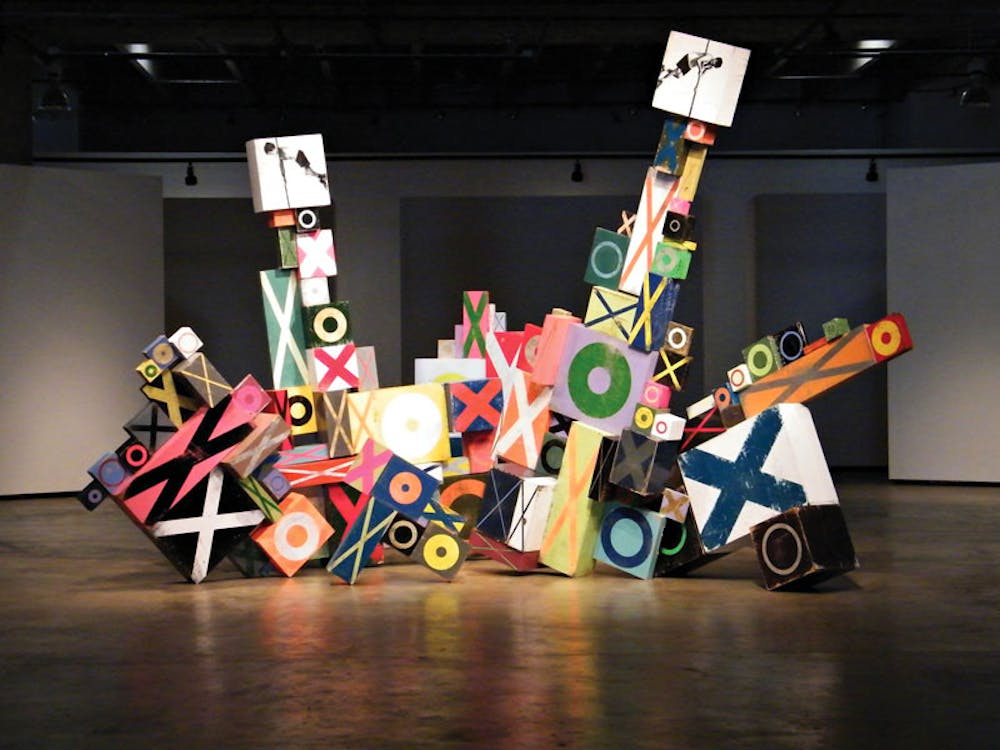Humans like to make stuff.
This exercise in generating objects, art and ideas — the act of creating — was the focus of the lecturers who spoke at the first installment of the Creative Mind Lecture Series Tuesday night in the Perry and Marty Granoff Center for the Creative Arts. The evening included three 20-minute presentations and a question-and-answer session in which speakers engaged with creativity and innovation across art, engineering and design.
The series is a “rebranding” of last semester’s Brown-RISD Art Science Evening Rendezvous, said Vivian Carlson ’14, co-organizer of the series. “It’s still the same essence of bringing in artists and scientists and people in different fields to talk about creativity in their work and to inspire students.”
The lecture series is sponsored by the Creative Mind Initiative, which seeks to “explore the roots of creative thinking and dissolve disciplinary boundaries in search of new modes of teaching and learning,” according to the initiative’s website.
The initiative sponsors an array of courses, projects and conversations across campus and online, said Ian Gonsher, associate director of the Creative Mind Initiative and adjunct lecturer at the School of Engineering. The initiative’s efforts include activities such as Creative Scholars, a series of panels inviting faculty members to take part in “critical analysis of the creative process,” and Conversations, a web series allowing faculty members to discuss creativity in their fields, which include neuroscience, archaeology, biology and visual art, Gonsher said.
“Basically the broad statement is that we want to help promote and help nurture creativity at Brown,” he added.
Joseph Zinter, assistant director of the Yale Center for Engineering Innovation Design, kicked off the evening with a talk about creating “a resource that’s open to the Yale community to collaborate, to generate ideas and to provide the resources necessary to realize those ideas.”
The center includes a design space, woodshop, machine shop, wet lab, lecture area and meeting rooms for students, faculty members and community members to hold classes, workshops and social events, Zinter said. The resources available to students range from hammers and saws to 3-D printers and laser cutters.
Zinter pointed to an “interesting shift” in modern design that the center incorporated into its philosophy. “On the one hand, you have some really interesting tools and techniques that are emerging,” he said. “On the other hand, you have this very rapid change in pedagogy — design thinking, human-centered design, emergent thinking, interdisciplinary thinking, all of which are no longer on the horizon, but they’re here.”
The resources that “makers” have at their fingertips today are more accessible and efficient than they were 20 or even 10 years ago, said the next lecturer, Kipp Bradford ’95 ScM ’96, senior design engineer and lecturer at the School of Engineering.
As co-founder of Revolution by Design, he organizes the Rhode Island Mini Maker Faire, an event at which creators of everything from Chantilly lace to robots come together to share their work and exchange ideas.
He recalled “sneaking around workshops” at the Rhode Island School of Design as an undergraduate and experimenting with the tools available in the industrial design spaces. Though he studied biomedical engineering at Brown, he found himself drawn to designing air conditioning units and toys rather than writing research papers in a lab, he said.
“I wanted to be someone who made a difference,” he said. “As an engineer, I had the tools to make that happen.”
The last speaker, Jonathan Saiz, a contemporary artist currently based in Denver, spoke about spending a year in Mykonos, Greece, working on a project called Alkahest, named for the universal solvent medieval alchemists believed to exist. He came up with a body of crystalline, fractal paintings incorporating random images he collected from across the Internet into a distorted, geometric pastiche, he said.
He emphasized the “nonlinear” approach he took in solidifying and becoming comfortable with his own style. “It was kind of visualizing this funnel, and all of my projects were bouncing back and forth between what I was capable of doing, but there was quite a big swing,” he said.
His early work included small paintings arranged into sculptural elements, miniature portraits and even a piano painted with flowers and hummingbirds. Last December, he presented miniature portraits of Sasha and Malia Obama to First Lady Michelle Obama at the White House Christmas Party.
“Then I noticed as the years went by, even when I had a project that seemed on the far left side or the far right, they were getting closer and closer together,” he said.
Granoff facilitates these kinds of creative interactions, Gonsher said. “You see somebody dancing up here while you’re working on a computer. Or you see somebody working on some kind of technical robot in a physical media lab while you’re down in the art gallery,” he said. “So there’s this fluid exchange of creative energy that permeates the building.”
The Creative Mind Initiative will next sponsor a lecture from artist Carrie Mae Weems May 2.

ADVERTISEMENT




